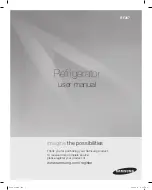
13
Preparations for Freezing
•
Use quality food and handle it as little as possible. Freeze food in small quantities as it freezes faster,
takes less time to defrost and enables you to control the quantity you need better.
•
Leave cooked food to cool completely. Chill food before freezing if possible.
•
Consider how you will want to cook the food before freezing it.
•
Don’t freeze food in metal containers if you want to microwave it straight from the freezer.
•
Use special freezer bags, freezer film, polythene bags, plastic containers, and aluminium foil (heavy
duty grade only). If in doubt, double wrap your food. Don’t use aluminium foil for acidic foods, e.g.
citrus fruits. Don’t use thin cling film, glass, or used food containers without cleaning.
•
Exclude as much air from the container as possible. You could buy a special vacuum pump which sucks
excessive air out of the packaging.
•
Leave a small amount of air space when freezing liquids to allow expansion.
•
You can use the space in the freezer most efficiently if you freeze liquids (or solids
with liquids, e.g. stew) in square blocks. This is known as “Preforming”. Pour the
liquid into a polythene bag which is inside a square sided container. Freeze it, and
then remove it from the container and seal the bag.
•
Label your frozen foods as they will look the same when in frozen state. Use special
fridge freezer tapes, labels and pens with different colours. This allows you to easily
organise and to effectively use the freezer. Write the contents and date; otherwise
the frozen food might exceed the storage time and this could cause food
poisoning. Please refer to your food packaging for the recommended storage time.
•
You may also add the weight and cooking notes, e.g. “defrost first”, “cook from
frozen” and keep a separate log of what is in each drawer. This will save opening the door and
searching around unnecessarily. .
Defrosting Frozen Food
1. Take the frozen food out from the freezer compartment and uncover the frozen food. Let it defrost at
room temperature. Don’t forget that defrosting in a warm area encourages the growth of bacteria and
low temperature cooking may not destroy dangerous bacteria.
2. Drain off and throw away any liquid lost during defrosting.
3. Always make sure there are no ice-crystals in the food before cooking, particularly with meat. These
crystals indicate that the food has not fully defrosted.
4. Cook food as soon as possible after defrosting.
5. Many microwaves and ovens have a defrost setting. To avoid bacterial build up, only use these if you
intend to cook the food immediately afterwards.
Never refreeze anything that has been defrosted unless you cook it again, to kill off harmful
bacteria. Never re-freeze defrosted shellfish. Re-seal packs properly after removing items. This
prevents drying or freezer-burn and a build up of frost on any remaining food.
LFC60W11_IB_final110511.indd 13
11/05/2011 10:00 AM
Summary of Contents for LFC60W11
Page 1: ...Fridge Freezer Instruction Manual LFC60W11 LFC60W11_IB_final110511 indd 1 11 05 2011 9 59 AM...
Page 2: ...LFC60W11_IB_final110511 indd 2 11 05 2011 9 59 AM...
Page 20: ...LFC60W11_IB_final110511 indd 20 11 05 2011 10 00 AM...
Page 21: ...LFC60W11_IB_final110511 indd 21 11 05 2011 10 00 AM...
Page 22: ...LFC60W11_IB_final110511 indd 22 11 05 2011 10 00 AM...
Page 23: ...LFC60W11_IB_final110511 indd 23 11 05 2011 10 00 AM...
Page 24: ...LFC60W11_IB_final110511 indd 24 11 05 2011 10 00 AM...










































